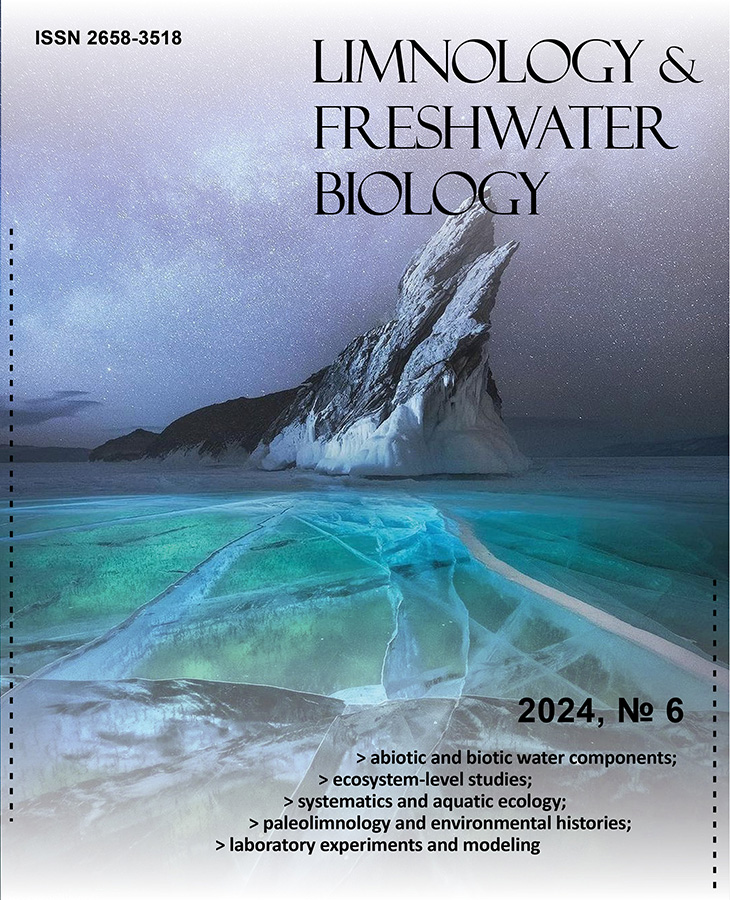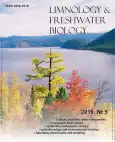Changes in lipid composition and lipid peroxidation products content in the freshwater mussel Anodonta cygnea L. under cadmium effect
- Авторы: Fokina N.N.1, Vasil’eva O.B.1, Ruokolainen T.R.1, Nemova N.N.1
-
Учреждения:
- Institute of Biology of Karelian Research Centre of Russian Academy of Sciences
- Выпуск: № 5 (2019)
- Страницы: 286-296
- Раздел: Статьи
- URL: https://journal-vniispk.ru/2658-3518/article/view/292302
- DOI: https://doi.org/10.31951/2658-3518-2019-A-5-286
- ID: 292302
Цитировать
Полный текст
Аннотация
In order to identify specific biomarkers to cadmium-induced oxidative stress in freshwater organisms, changes in the composition of membrane and storage lipids and their fatty acids in the gills and digestive glands of freshwater mussels, Anodonta cygnea (Linnaeus, 1758), exposed to cadmium ions at 10, 50 and 100 µg/L were studied. Cadmium-induced oxidative stress was estimated by the content of lipid peroxidation products such as conjugated dienes and trienes, malondialdehyde, and Schiff bases. Accumulation of lipid peroxidation products in the gills and digestive glands reflected the intensity of lipid peroxidation, depending on the concentration and duration of cadmium exposure. Changes in the fatty acid composition of phospholipids and triacylglycerols reflected their compensatory role in the response of the mussels to the action of cadmium at various concentrations. Some indices of lipid composition (phosphatidylserine and triacylglycerol content) similarly altered under cadmium effect in both marine and freshwater mussels. The assessment of oxidative stress biomarkers and the main targets for these oxidative processes including lipids and their fatty acid composition makes it possible to identify protective biochemical mechanisms providing the high resistance of mussels to environmental pollution.
Ключевые слова
Об авторах
N. Fokina
Institute of Biology of Karelian Research Centre of Russian Academy of Sciences
Автор, ответственный за переписку.
Email: fokinann@gmail.com
Россия, Pushkinskaja St. 11, 185910 Petrozavodsk
O. Vasil’eva
Institute of Biology of Karelian Research Centre of Russian Academy of Sciences
Email: fokinann@gmail.com
Россия, Pushkinskaja St. 11, 185910 Petrozavodsk
T. Ruokolainen
Institute of Biology of Karelian Research Centre of Russian Academy of Sciences
Email: fokinann@gmail.com
Россия, Pushkinskaja St. 11, 185910 Petrozavodsk
N. Nemova
Institute of Biology of Karelian Research Centre of Russian Academy of Sciences
Email: fokinann@gmail.com
Россия, Pushkinskaja St. 11, 185910 Petrozavodsk
Список литературы
- Arduini A., Peschechera A., Dottori S. et al. 1996. High performance liquid chromatography of long-chain acylcarnitine and phospholipids in fatty acid turnover studies. Journal of Lipid Research 37: 684-689.
- Avery E.L., Dunstan R.H., Nell J.A. 1998. The use of lipid metabolic profiling to assess the biological impact of marine sewage pollution. Archives of Environmental Contamination and Toxicology 35: 229-235. doi: 10.1007/s002449900371
- Bird R.P., Draper H.H. 1984. Comparative studies on different methods of malondialdehyde determination. Methods in Enzymology 90: 105–110.
- Chelomin V.P., Belcheva N.N., Zakhartsev M.V. 1998. Biochemical mechanisms of adaptation to cadmium and copper ions in the mussel Mytilus trossulus. Russian Journal of Marine Biology 24: 330-336.
- Engelbrecht F.M., Mari F., Anderson J.T. 1974. Cholesterol determination in serum: a rapid direction method. South African Medical Journal 48: 250-256.
- Fokina N.N., Ruokolainen T.R., Nemova N.N. 2018. The effect of intertidal habitat on seasonal lipid composition changes in blue mussels, Mytilus edulis L., from the White Sea. Polar Record 54: 133-151. doi: 10.1017/S0032247418000293
- Fokina N.N., Ruokolainen T.R., Nemova N.N. et al. 2013. Changes of blue mussels Mytilus edulis L. lipid composition under cadmium and copper toxic effect. Biological Trace Element Research 154: 217-225. doi: 10.1007/s12011-013-9727-3Folch J., Lees M., Stanley J. 1957. A simple method for isolation and purification of total lipids from animal tissues. The Journal of Biological Chemistry 226: 497-509.
- Gavrilov V.B., Gavrilova A.R., Mazhul L.M. 1987. Analysis of methods for the determination of lipid peroxidation products in blood serum by the test with thiobarbituric acid. Voprosy Meditsinskoy Khimii [Questions of Medical Chemistry] 1: 118–121. (In Russian)
- Geret F., Serafim A., Barreira L. et al. 2002. Effect of cadmium on antioxidant enzyme activities and lipid peroxidation in the gills of the clam Ruditapes decussatus. Biomarkers 7: 242-256. doi: 10.1080/13547500210125040
- Gladyshev M.I., Anishchenko O.V., Sushchnik N.N. et al. 2012. Influence of anthropogenic pollution on content of essential polyunsaturated fatty acids in links of food chain of river ecosystem. Contemporary Problems of Ecology 5: 376-385. doi: 10.1134/S1995425512040051
- Gutteridge J.M., Halliwell B. 1990. The measurement and mechanism of lipid peroxidation in biological systems. Trends in Biochemical Sciences 15: 129-135. doi: 10.1016/0968-0004(90)90206-Q
- Hill T., Lewicki P. 2007. STATISTICS Methods and Applications. A comprehensive reference for science, industry, and data mining: StatSofr Inc.
- Hyshiktuyev B.S., Hyshiktuyeva N.A., Ivanov V.N. 1996. Methods of measuring of lipid peroxidation products in exhaled air condensate and their clinical significance. Klinicheskaia Laboratornaia Diagnostika [Clinical Laboratory Diagnostics] 3: 13–15. (in Russian)
- Kelly J.R., Scheibling R.E. 2012. Fatty acids as dietary tracers in benthic food webs. Marine Ecology Progress Series 446: 1-22. doi: 10.3354/meps09559
- Koukouzika N., Dimitriadis V.K. 2008. Aspects of the usefulness of five marine pollution biomarkers, with emphasis on MN and lipid content. Marine Pollution Bulletin 56: 941-949. doi: 10.1016/j.marpolbul.2008.01.043
- Manly R., George W.O. 1977. The occurrence of some heavy metals in populations of the freshwater mussel Anodonta anatina (L.) from the River Thames. Environmental Pollution 14: 139-154. doi: 10.1016/0013-9327(77)90106-9
- Marigómez I., Soto M., Cajaraville M.P. et al. 2002. Cellular and subcellular distribution of metals in molluscs. Microscopy Research and Technique 56: 358-392. doi: 10.1002/jemt.10040
- Méndez-Armenta M., Ríos C. 2007. Cadmium neurotoxicity. Environmental Toxicology and Pharmacology 23: 350-358. doi: 10.1016/j.etap.2006.11.009
- Merad I., Bellenger S., Hichami A. et al. 2017. Effect of cadmium exposure on essential omega-3 fatty acids in the edible bivalve Donax trunculus. Environmental Science and Pollution Research 25: 18242–18250. doi: 10.1007/s11356-017-9031-4
- Moore M.N., Viarengo A., Donkin P. et al. 2007. Autophagic and lysosomal reactions to stress in the hepatopancreas of blue mussels. Aquatic Toxicology 84: 80-91. doi: 10.1016/j.aquatox.2007.06.007
- Napolitano G.E. 1999. Fatty acids as trophic and chemical markers in freshwater ecosystems. In: Lipids in freshwater ecosystems. New York, pp. 21-44.
- Ohkawa H., Ohishi N., Yagi K. 1979. Assay for lipid peroxides in animal tissues by thiobarbituric acid reaction. Analytical Biochemistry 95: 351-358. doi: 10.1016/0003-2697(79)90738-3
- Oxidative stress in aquatic ecosystems. 2011. In: Abele D., Vazquez-Medina J.P., Zenteno-Savin T. (Eds.). London: John Wiley & Sons.
- Perceval O., Pinel-Alloul B., Méthot G. et al. 2002. Cadmium accumulation and metallothionein synthesis in freshwater bivalves (Pyganodon grandis): relative influence of the metal exposure gradient versus limnological variability. Environmental Pollution 118: 5-17. doi: 10.1016/S0269-7491(01)00282-2
- Perrat E., Couzinet-Mossion A., Tankoua O.F. et al. 2013. Variation of content of lipid classes, sterols and fatty acids in gonads and digestive glands of Scrobicularia plana in relation to environment pollution levels. Ecotoxicology and Environmental Safety 90: 112-120. doi: 10.1016/j.ecoenv.2012.12.019
- Ravera O. 1984. Cadmium in freshwater ecosystems. Experientia 40: 1-14. doi: 10.1007/BF01959096
- Regoli F., Nigro M., Orlando E. 1998. Lysosomal and antioxidant responses to metals in the Antarctic scallop Adamussium colbecki. Aquatic Toxicology 40: 375-392. doi: 10.1016/S0166-445X(97)00059-3
- Repetto M., Semprine J., Boveris A. 2012. Lipid peroxidation: chemical mechanism, biological implications and analytical determination. In: Catala A. (Ed.), Lipid peroxidation. Rijeka, pp. 3-31. doi: 10.5772/45943
- Sevanian A., Hochstein P. 1985. Mechanisms and consequences of lipid peroxidation in biological systems. Annual Review of Nutrition 5: 365-390.
- Sidorov V.S., Lizenko E.I., Bolgova O.M. et al. 1972. Fish lipids. 1. Analysis technique. In: Potapova O.I., Smirnov Y.A. (Eds.), Lososevyye (Salmonidae) Karelii. Petrozavodsk, pp. 150-162. (in Russian).
- Slukovskii Z.I., Ilmast N.V., Sukhovskaya I.V. et al. 2017. The geochemical specifics of modern sedimentation processes on the bottom of a small lake Lamba under technogenic impact. Trudy Karel’skogo Nauchnogo Tsentra Rossiyskoy Akademii Nauk [Transactions of Karelian Research Centre of Russian Academy of Science] 10: 45-63. doi: 10.17076/lim618 (in Russian)
- Suzuki R., Noguchi R., Ota T. et al. 2001. Cytotoxic effect of conjugated trienoic fatty acids on mouse tumor and human monocytic leukemia cells. Lipids 36: 477-482. doi: 10.1007/s11745-001-0746-0
- Traverso N., Menini S., Maineri E.P. et al. 2004. Malondialdehyde, a lipoperoxidation-derived aldehyde, can bring about secondary oxidative damage to proteins. The Journals of Gerontology Series A: Biological Sciences and Medical Sciences 59: 890-895. doi: 10.1093/gerona/59.9.B890
- Valko M.H.C.M., Morris H., Cronin M.T.D. 2005. Metals, toxicity and oxidative stress. Current Medicinal Chemistry 12: 1161-1208. doi: 10.2174/0929867053764635
- Viarengo A., Canesi L., Pertica M. et al. 1990. Heavy metal effects on lipid peroxidation in the tissues of Mytilus galloprovincialis lam. Comparative Biochemistry and Physiology Part C: Comparative Pharmacology 97: 37-42. doi: 10.1016/0742-8413(90)90168-9
- Wadige C.P.M., Maher W.A., Taylor A.M. et al. 2014. Exposure–dose–response relationships of the freshwater bivalve Hyridella australis to cadmium spiked sediments. Aquatic Toxicology 152: 361-371. doi: 10.1016/j.aquatox.2014.04.016
- Waller R.L., Recknagel R.O. 1977. Determination of lipid conjugated dienes with tetracyano‐ethylene‐14C: Significance for study of the pathology of lipid peroxidation. Lipids 12: 914-921. doi: 10.1007/BF02533311
- Xia L., Chen S., Dahms H.U. et al. 2016. Cadmium induced oxidative damage and apoptosis in the hepatopancreas of Meretrix meretrix. Ecotoxicology 25: 959-969. doi: 10.1007/s10646-016-1653-7
Дополнительные файлы










